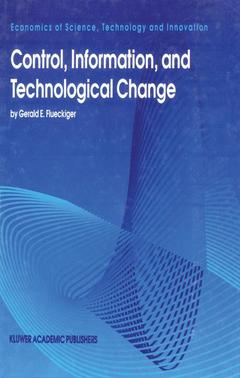Control, Information, and Technological Change, Softcover reprint of the original 1st ed. 1995 Economics of Science, Technology and Innovation Series, Vol. 6
Langue : Anglais
Auteur : Flueckiger Gerald E.

Information theory, cybernetics and the theory of finite automata are used to model learning-by-doing, bounded rationality, routine behavior, and the formation of teams. The non-neoclassical characterization of production developed in this book ignores the usual quantitative relationships between inputs and outputs and instead views production strictly as a problem of control and communication. The motivation for this unconventional characterization of production comes from Schumpeter's critique of neoclassical economic theory. Schumpeter argued that neoclassical economic theory, and the habits of thought engendered by it, was the major obstacle to acquiring an understanding of technological change. The non-neoclassical characterization of production developed in this book is in keeping with how economic historians describe specific technological changes and how they write technological histories about particular machines, firms or industries.
1 Control.- The Furnace and the Computer.- Technological Changes and Production Processes.- Stress inside the Black Box.- Hierarchy.- Two Views of the “Perfect Machine”: Errors Avoided, Errors Corrected.- Summary.- 2 Behavior: Perception and Execution.- A Productive Entity.- An Intuitive Description of Behavior and Learning.- Perception Behavior.- Execution Behavior.- Summary.- 3 Learning to Make Distinctions.- Learning to Make Distinctions: The Algorithm A.- The Set of Internal States.- A Finite Automaton.- Learning in a Contrived Environment without Execution Constraints.- Learning and Behavior with and without Execution Constraints.- Learning in a Stochastic Environment.- The Decision to Learn.- Summary.- 4 The Law of Requisite Variety.- Variety for Communication, Variety for Control.- Summary.- 5 Behavior: Routines and Bounded Rationality.- A Sketch of the Argument.- A Productive Entity as a Communication/Control Device.- Rationality: An Intuitive Overview.- The Information Function ?.- The Decision Function ?.- The Outcome Function ?.- The Outcome Function ?*.- A Comparison of Finite Automata.- Ashby’s Law of Requisite Variety, Routine Behavior, and the Communication/Control Duality.- Summary.- 6 Information Theory and Coding.- Information.- The Unit of Measurement.- Codes.- Some Examples of Codes.- Summary.- 7 The Unit of Analysis Problem: Two Conjectures.- Routines, Relative Frequencies, and the Invisible Hand.- Teams: From Individuals to Systems.- The Team as a Composition of Finite Automata.- Summary.- 8 Concluding Remarks.- Control/Communication, Information, and Finite Automata.- What’s Next? Looms and Other Computing Devices.- Endnotes.- References.
Date de parution : 10-2012
Ouvrage de 155 p.
16x24 cm
Thème de Control, Information, and Technological Change :
Mots-clés :
Schumpeter; bounded rationality; communication; economic theory; information theory; production
© 2024 LAVOISIER S.A.S.



